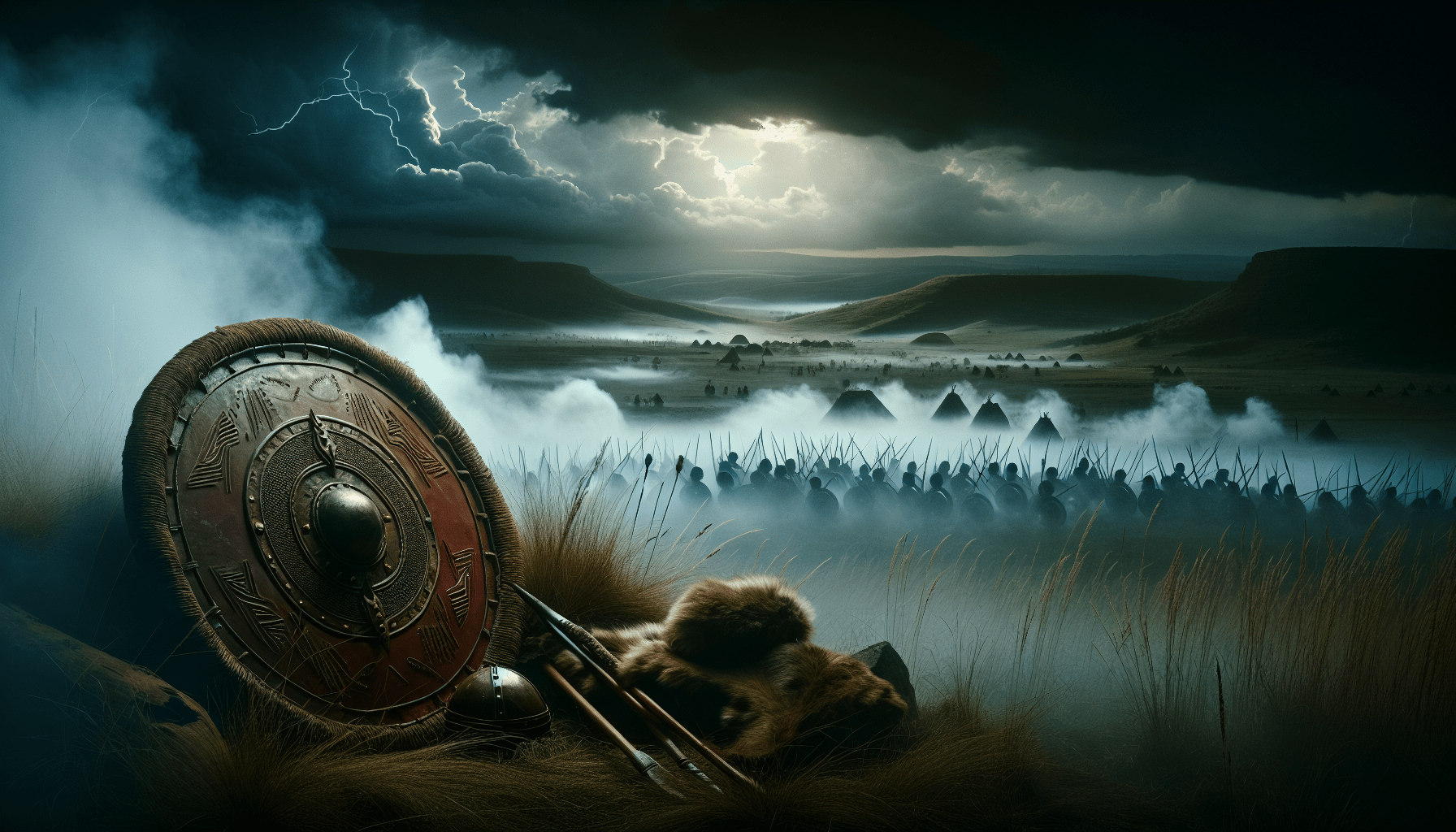The Battle of Blood River, fought on December 16, 1838, marks a pivotal moment in the tumultuous interactions between the Voortrekkers, predominantly Dutch settlers, and the Zulu Kingdom in what is now KwaZulu-Natal, South Africa. This encounter, featuring a significantly smaller Boer force of 464 led by Andries Pretorius against an estimated 25,000 to 30,000 Zulu warriors commanded by King Dingane, exemplifies the intricate dynamics of power, betrayal, and territorial control that characterized this period. The battle resulted in staggering casualties, with over 3,000 Zulu soldiers killed, including two princes, further intensifying the political volatility within the Zulu ranks.
This article examines the escalation of tensions that preceded the battle, detailing the key events that led to the confrontation. It explores the critical strategies employed by Pretorius and the impact of Zulu internal conflicts, culminating in an analysis of the aftermath and its significance for land ownership and governance in the region. The legacy of the Battle of Blood River extends beyond military conflict, shaping the socio-political landscape for future generations in South Africa.
The Battle of Blood River: An Examination of Conflict and Consequence
Historical Context
Overview of the Voortrekkers
The Voortrekkers were a group of Afrikaner pioneers of Dutch, German, and French Huguenot descent who embarked on a series of migrations known as the Great Trek during the 1830s and 1840s. Seeking autonomy from British colonial rule in the Cape Colony, these settlers moved inland into the interior of South Africa, ultimately forging new communities. Their exodus was marked by a profound desire for self-determination, yet it also set the stage for significant conflict with indigenous populations, particularly the Zulu nation. You will note that the Voortrekkers’ journey was not merely about land acquisition; it was intertwined with questions of identity, sovereignty, and governance.
The Zulu Kingdom and King Dingane
The Zulu Kingdom, established by King Shaka in the early 19th century, had rapidly grown into a formidable power in Southern Africa. By the time of King Dingane’s ascendancy, the kingdom was marked by extensive military prowess and a complex society. However, Dingane’s reign was beset by internal strife and external pressures as the Zulu struggled to maintain their territorial integrity in the face of European encroachment. Your understanding of King Dingane is vital; he was a ruler grappling with the dual challenges of sustaining his empire and responding to the relentless expansion of the Voortrekkers, whose ambitions threatened the very fabric of Zulu society.
Colonial Land Conflicts in South Africa
The onset of colonial expansion in South Africa led to increasing tensions over land and resources. The Voortrekkers, while seeking independence, often found themselves in direct competition with the Zulu for control of fertile land and trade routes. You must recognize that these land conflicts were not mere skirmishes; they were symptomatic of broader imperial ambitions that saw land as both a resource and a battleground for cultural dominance. The complexity of these conflicts set the stage for the inevitable clash that would occur at Blood River.
The Causes of Conflict
Tensions Between the Boers and the Zulus
Tensions escalated significantly in the lead-up to the Battle of Blood River as both the Voortrekkers and the Zulu increasingly viewed each other as existential threats. For the Voortrekkers, the Zulu represented a formidable, organized army that could jeopardize their aspirations for land and security. Conversely, for the Zulu, the encroachment of the Voortrekkers was seen as an invasion, an unsought violation of their territory. The betrayal during the beer-drinking farewell extended these tensions dramatically, transforming a complex rivalry into outright hostility.
The Role of Resource Control
Resource control was pivotal in fueling the conflict between these two groups. The Voortrekkers sought fertile land for agriculture, while the Zulu aimed to secure grazing areas for their cattle. Access to water resources also loomed large in the power dynamics of the region, as droughts and food scarcity exacerbated tensions. You can see that the struggle for resources became a zero-sum game, where one group’s gain was perceived as another’s loss, solidifying the path toward conflict.
The Betrayal at the Beer Drinking Farewell
The Betrayal at the Beer Drinking Farewell on February 6, 1838, marked a critical turning point. King Dingane invited Voortrekker leaders, including Piet Retief, to discuss land issues, welcoming them into his royal residence. Yet, this gathering ended with the massacre of Retief and his men, a betrayal that ignited outrage among the Voortrekkers. For you, understanding this event highlights how acts of trust can pivot into acts of war, setting off a chain reaction of retaliation, consolidation of war efforts, and ultimately, the Battle of Blood River.

Preparations for Battle
Andries Pretorius and the Boer Forces
Andries Pretorius emerged as a pivotal figure in the Voortrekker response to Dingane’s betrayal. Appointed as commander of a combined force of over 500 heavily armed fighters, Pretorius guided the Voortrekkers through strategic planning and mobilization. His ability to unify the disparate groups of the Voortrekkers and prepare them for battle was crucial. You will see that his leadership was characterized by a combination of military acumen and deep-rooted cultural convictions, aiming to ensure the survival of his people.
Zulu Military Strategies Under Dingane
King Dingane, despite the internal challenges within his ranks, commanded a sizeable army equipped with traditional Zulu warfare techniques. The Zulu military strategy incorporated mobility, formation, and the renowned “horns of the buffalo” tactic, which utilized flanking maneuvers to encircle enemies. Recognizing these strategies enables you to appreciate how the Zulu, under Dingane’s leadership, intended to exploit their numerical superiority despite being up against a well-armed foe.
The Internal Zulu Conflict: A Divided Leadership
The internal divisions within the Zulu leadership also played a significant role leading up to the battle. With Prince Mpande’s faction disillusioned with Dingane’s rulership, their potential defection weakened Dingane’s military capacity. For you, this internal discord is emblematic of how political divisions can shape the outcomes of military confrontations, creating an environment wherein external conflicts can take advantage of internal strife.
The Location of the Battle
Geographical Significance of the Ncome River
The Battle of Blood River took place near the Ncome River, an area that was both strategically significant and naturally fortified. The river formed a natural barrier for the Zulu while offering the Voortrekkers advantageous terrain for defense. Understanding this geographical context helps you grasp how environmental factors influenced tactical decisions and the ease or difficulty of troop movements, adding layers to the narrative of the battle.
Natural Barriers and Defensive Tactics
The Voortrekkers’ chosen defensive position was meticulously planned. The topography around the Ncome River included steep ravines and less accessible terrains, which created formidable natural defenses. The placement of ox wagons to create a lager or encampment fortified their position against Zulu assaults. Your comprehension of these tactics emphasizes the importance of strategic military positioning and how it can dramatically alter the course of battle.
The Boer Stronghold: Logistics of the Lager
The logistics behind constructing the lager showcased Pretorius’s foresight. The composition of the lager, which included defensive measures and firing points, was critical in repelling the Zulu assaults. With minimal losses, Pretorius’s calm resolve and strategic choices in setting up the lager fortified Boer morale while converting fear into tactical determination. You should reflect on how these logistical considerations are critical in warfare, where resource allocation and spatial awareness can dictate outcomes.

The Day of the Battle
Dawn on the 16th of December 1838
On the morning of December 16, 1838, a clear day unfolded as the Voortrekkers prepared for the impending assault. The visible tranquility of dawn belied the conflict that would soon erupt. This juxtaposition speaks to the collective psyche of the Voortrekkers, balancing anticipation with apprehension. For you as a scholar, this is an example of how the psychological preparatory rituals in battle can be just as important as the physical logistics of warfare.
First Engagements and Initial Zulu Assaults
The first engagements revealed the contrasting military tactics of the two forces. The Zulu, numbering possibly as many as 30,000, organized their assaults in waves, relying on their traditional combat techniques. In contrast, the Voortrekkers utilized their firearms, resulting in devastating effectiveness against the advancing Zulu ranks. Your analysis of these opening exchanges underscores the critical introduction of firearms into traditional warfare and how technology shifted power dynamics in historic battles.
Boer Countermeasures and Tactical Response
The Boer forces, faced with overwhelming numbers, relied on their training, superior weaponry, and fortifications to withstand the Zulu onslaught. As Zulu troops repeatedly charged their position, the Voortrekkers executed countermeasures, conserving their ammunition and positioning their forces to maximize firepower. This moment is significant for you, illustrating how tactical ingenuity can counterbalance numerical disadvantages in warfare.
Battle Tactics and Strategies
Zulus’ Assault Patterns and Adaptations
As the battle progressed, the Zulus attempted to adapt their tactics in response to the Boer defenses. However, they found their traditional strategies ineffective against the concentrated fire of the Boer firearms. The Zulu soldiers faced daunting challenges in trying to breach the lager. For you, this emphasizes the necessity of adaptability in military leadership, as rigidity can often lead to catastrophic failure.
Boer Firearm Use and Defensive Positions
The Voortrekkers’ proficiency in firearm usage was pivotal in the battle. Utilizing rifles and cannons, they inflicted substantial casualties on Zulu forces. The defensive configurations fostered a pinpoint focus on limiting Zulu advances while maximizing their own firepower. Recognizing this aspect of the battle will allow you to appreciate how the integration of firearms into indigenous combat situations marked a significant shift in military history.
Role of Cavalry in the Boer Strategy
Cavalry played an essential role in the Boer strategy, particularly in exploiting any gaps that emerged during the battle. Pretorius utilized cavalry forces to raid Zulu flanks and pursue fleeing troops after their formations began to disintegrate. The inclusion of cavalry in the Boer tactics demonstrated a comprehensive approach to warfare that recognized the importance of mobility and surprise. For you, this illustrates the multifaceted nature of combat strategy, where multiple units operate synergistically to achieve victory.

The Aftermath of the Battle
Casualties and Losses on Both Sides
The battle concluded with staggering casualties, with estimates suggesting over 3,000 Zulu soldiers dead, including two princes. The Voortrekkers, by contrast, sustained minimal losses, with only three lightly wounded, including their leader, Pretorius. The balance of casualties speaks volumes about the effectiveness of the Boer strategies and technology during the engagement. You will find that these figures not only highlight the human cost of conflict but also the subsequent power paradigm shifts resulting from such asymmetric warfare.
Effects on Zulu Military Authority
The ramifications of Blood River profoundly affected Zulu military authority. The loss signaled a weakening of Dingane’s power and contributed to a potential shift in the Zulu political landscape, paving the way for rival factions, notably that of Prince Mpande, to rise in prominence. For you, this demonstrates how military defeats can catalyze political transformations, altering loyalty structures within a society.
Immediate Consequences for the Voortrekkers
For the Voortrekkers, the victory at Blood River became a defining moment in their identity. It reinforced their belief in divine favor and validated their struggle for autonomy. The aftermath also defined their territorial claims and granted them a significant foothold in the region. Understanding these immediate repercussions helps clarify how victory in conflict can lead to affirmation of identity and justify expansionist ambitions.
Long-term Impacts
Shifts in Control over Land and Resources
The defeat of the Zulus at Blood River initiated a profound shift in the control of land and resources within the region. The Voortrekkers, emboldened by their victory, expanded their settlements into Zulu territories, leading to systemic displacement of the Zulu population. For you, assessing these long-term impacts questions the ethics of land ownership and historical narratives often framed in victor’s terms.
The Rise of Prince Mpande in Zulu Politics
The political landscape further evolved following the battle, with Prince Mpande assumed a central role in Zulu politics after Dingane’s loss of authority. His defection to the Voortrekkers’ side was critical in the eventual overthrow of Dingane. Analyzing Mpande’s rise allows you to see how conflicts lead to shifts in power dynamics, reshaping the identities and alliances of the groups involved.
Changing Dynamics of Boer and Zulu Relations
The relationship between the Boers and the Zulu underwent a transformation post-Blood River. While the Voortrekkers emerged victorious, the memory of the confrontation tempered relations and established a long-lasting cycle of conflict and mutual misunderstanding. Your exploration of these changing dynamics can reveal how trauma from conflicts can shape intergroup relations for generations, echoing in the social fabric of both communities.
Cinematic Representation in Total War
Game Mechanics and Historical Accuracy
In contemporary representations, such as within the “Total War” video game series, the Battle of Blood River is depicted through various game mechanics that strive to balance historical accuracy with engaging gameplay. Elements like troop formations, terrain advantages, and resource allocation mirror actual military strategies of the time, providing users with a simulation of the battle’s complexities. You should critique how these mechanics enhance or dilute understanding of historical events, reflecting a broader dialogue in gaming about the representation of conflict.
Cinematic Techniques Used in Battle Simulation
Cinematic techniques employed in the depiction of the battle offer players an engaging, immersive experience. The evocation of tension and chaos through sound design and visual elements can evoke the emotional weight of the conflict. Understanding these methods allows you to appreciate how historical narratives are conveyed through modern media and shape perceptions of events like the Battle of Blood River.
Player Experience and Engagement with History
As players command forces in a simulated Blood River scenario, they not only engage with the mechanics but also with a distilled representation of a historical moment. This interaction can foster a deeper interest in the complexities of the conflict and its historical consequences. For you, this passing interaction emphasizes the potential for games as educational tools, providing players avenues to explore and reflect upon historical narratives while promoting critical thought about warfare and its implications.
Conclusion
Summary of Key Points
The Battle of Blood River serves as a complex illustration of conflict and consequence, highlighting the interactions between settlers and indigenous groups amid colonial ambitions. Each contributing factor—from the socio-political landscape to the geographical setting—shaped the dramatic confrontation that unfolded on December 16, 1838. You must consider not only the immediate battle dynamics but also the extensive repercussions on Zulu and Boer relations that followed.
Reflection on the Historical Importance
The importance of the Battle of Blood River extends beyond the battlefield to inform our understanding of colonial narratives, identity formation, and the cyclical nature of conflict. The battle exemplifies how historical events are woven with layers of tragedy, resilience, and shifting power relations. Your reflection on these elements will contribute to the overarching discourse about South Africa’s tumultuous history and its enduring impacts.
Lessons Learned from the Conflict
In examining the Battle of Blood River, one must draw lessons about the fragility of trust and the heavy toll of betrayal that can escalate into violence. The consequences of conflict, both immediate and long-term, provoke critical questions regarding justice, land rights, and mutual recognition. As you engage with this historical event, consider the broader implications that resonate through time, challenging the narratives we construct around conflict and the lessons they impart for future generations.
